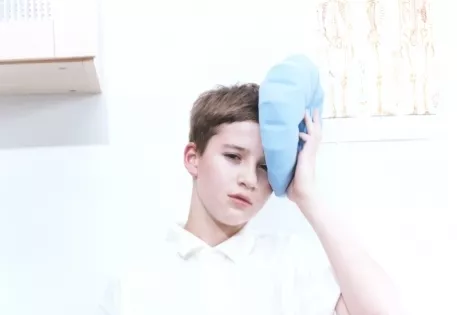Summer for children is a period of carefree holidays, active games in the fresh air, racing on bicycles and roller skates. And at the same time - the time for bruises, broken knees and bruised elbows... Do you know how to properly provide first aid to a child with bruises? If not or in doubt, our instructions will help!
So, let’s say some kind of “accident” occurred (for example, a child lost control of a bicycle, or went too fast on roller skates, got carried away by something and tripped, etc.), as a result of which the child was hit and hurt.
You don’t see an open bleeding wound or abrasion - there’s nothing to wash or disinfect, but how can you determine the exact location of the bruise? And what to do next with this?
The following symptoms will indicate the location of the injury in a child:
The child complains of pain in a specific place (knee, shoulder, elbow, etc.);
There is always a slight swelling (tissue edema) at the site of the bruise;
A bruise very quickly “draws” at the site of the injury, which changes color over time (as a rule, at first it is bright red, then turns blue, after a few days it turns into a pale yellow-green, etc.)
In simple terms, a bruise is a closed tissue injury, within which bleeding occurs from an impact (which is the cause of a change in skin color, popularly known as a “bruise”).
Bruises in children happen all the time, sometimes severe and not so strong, but with proper first aid they usually disappear without a trace and without consequences after a few days.
When helping a child with a bruise, the first step should be to take measures to stop the bleeding (despite the fact that it occurs unnoticed, under the skin, it is still dangerous). Simple but important measures:
The bruise should be pressed down (since any bleeding is stopped by applying pressure to the wound);
At the same time, cold should be applied to the child’s bruise site (to ensure spasm and constriction of the blood vessels). A cold pack from the refrigerator, or (at worst) a bag of frozen food from the freezer, or a plastic bottle of frozen water, etc., is perfect for this purpose. Before pressing the freezer onto the bruised area, wrap it with a thin soft towel or scarf. The ideal option is an individual cooling pack, which should be in any home or car first aid kit. Hit it with your palm (the capsule inside breaks and in seconds the bag becomes icy, but remains flexible), apply it to the child’s bruise and secure it with a pressure bandage.

Keep the cold on the site of the injury for about 30 minutes. The cooling bandage can then be removed.
What not to do when providing first aid to a child with a bruise:
rub the bruised area;
apply iodine mesh to the bruise;
apply warming elements (heating pads, warm compresses, etc.) to the injury site.
All these actions will lead to heating of the injured tissues and a rush of blood to them. This means that internal bleeding will not only not stop, but on the contrary, it will intensify, the bruise will take a long time to heal and the pain will also remain. In addition, heat creates a favorable environment for the development of inflammatory processes in tissues.
During the first two days, apply only cold things to the child’s bruise site - regularly and little by little: every 2-3 hours, apply cold pressure for 10-15 minutes. In this case, the pain will quickly subside, and the bruise will disappear in the shortest possible time.
During sleep, any bandages and frostings must be removed.
How to speed up the healing of a bruise in a child
Two days of “cold therapy” is enough to stop bleeding, relieve pain and minimize the risk of inflammatory processes. Now the task of parents is to speed up the healing process of the bruise as much as possible.
To do this, for 2-3 days, periodically apply a warm compress (a heating pad or a soft towel heated in the microwave) to the site of the child’s bruise. And create conditions for the child under which he will not put any strain on the bruised area.
In other words: if a child’s bruise gapes for a full length, football, bicycle racing and roller skating are canceled for the next few days. We'd rather watch cartoons and play Scrabble.
When a child’s bruise needs to be shown to a doctor
We have already mentioned that there are different types of bruises. And not all of them can be “cured” by simply providing the child with minimal first aid.

So, in what cases is it necessary to urgently show your child to a doctor:
if the child’s injury is on the head (especially in the eye area);
if a child gets hit in the side (no matter right or left);
if the child’s injury is in the abdomen or lower back;
if, over time, the pain at the site of the injury does not subside, but on the contrary, intensifies;
if the swelling at the site of the injury does not subside for more than a day;
if the bruise at the site of the injury does not change color within three days, or becomes hot;
if there are bruises under both eyes at once;
if there is a bruise behind the ear;
if the child has bruises without bumps or bruises;
if you suspect your child has a sprain or fracture.
In all other cases, it is quite possible to get by with “self-medication” and those simple first aid techniques for a child with bruises that we described above. And be patient a little - literally 3-4 days, and your baby, “like new,” will again be jumping around the yard like a restless “ball”...
There are no fun, mischievous childhood holidays without a few bruises and scratches. But if you can help your child correctly and adequately in these cases, then it’s not them that you and your children will remember, but the wonderful, interesting “cloudless” summer, lived in one breath...
Photo: Getty Images

